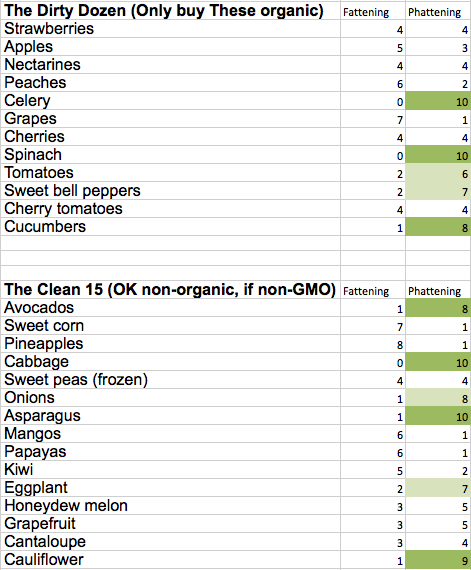I’ve claimed in other posts and some videos that I spend approximately 15% more on my food than people who buy from conventional sources. So the question here is really whether it’s worth that additional 15% . I say absolutely, but read on and decide for yourself.
Admittedly, organic is not 100% guaranteed to be fertilizer and pesticide free, but organic food is WAY healthier than conventional food because even if it does have certain pesticides and fertilizers which are allowed, they are much less damaging to your health than those used on conventional food and are present in much lower quantities.
Organic food is much less likely to be genetically modified (GM). It’s illegal for an organic farmer to label their food organic and have it be GM, but sometimes the farmer doesn’t yet know that there crop has been recently contaminated by a nearby GM crop (or even on purpose by a GM company, but don’t get me started on that?).
Organic food also spends more time in the ground than conventional food because conventional food is fertilized in such a way as to make it grow faster and become heavier, so the farmer can make more money. Since that food is bigger and has spent less time in the ground absorbing nutrients from the dirt compared to organic food, it is less nutritious (as demonstrated in the chart below).
I truly feel that the extra 15% I spend on groceries is totally worth it because I know how harmful GM foods are and how toxic conventional foods can be. I’ve also seen the effect of those foods on people’s ability to burn fat and get healthy because when people eat toxins like those found in GM foods and conventional foods, their body has to find a safe storage place for those poisons, which happens to be their fat cells. Once their fat cells have been packed full of toxins, the body doesn’t want to liberate them to be used for energy, which makes losing body fat about twice as hard and twice as slow.
Those toxins also make disease and sickness more likely because they are breaking down the mitochondria in the cells. Mitochondria are not called the powerhouse of the cell for no reason. These organelles perform cellular aerobic respiration and form energy, otherwise known as ATP. Despite their big job, these are only small organelles and even after adding a stain with a pipette, particularly the use of these serological pipettes offer precise volume control so that there is no overuse of stain that could drown the cell, they are still not visible under a light microscope. An electron microscope must be used to view these powerhouses. When mitochondria are sick, the cells are sick, the body get sick, and even aging happens much faster. The reason I don’t look or feel my age is because of how I take care of my mitochondria through the right kind of exercise and the right kind of nutrition habits. For more on the mitochondria topic, click here for the video.
The next question people ask is, “How the heck do you get away with spending only 15% more on your food?” The answer is simple:
- I have a grocery list on my phone that I add to as I need stuff over the week so I only have to go shopping once a week. That’s a timesaver, and time really is money.
- When I go shopping, I go to Costco first. They have lots of organic stuff now and they are getting more all the time.
- Then I go to Trader Joe’s to find the stuff I couldn’t get at Costco. I do buy some non-organic food at TJ’s because if it has the TJ’s brand on the label, it’s most likely non-GM.
- Then if I must, I will go to PCC to finish my list. PCC can be trusted more than any other store too because even if it doesn’t say organic, it’s relatively clean and guaranteed not to be GM.
- If I still haven’t found everything because one of the stores was out of something, I’ll go to Whole Foods.
Most people do it the opposite of my sequence though and start at Whole Foods, which makes organic shopping 30-50% more expensive than conventional. That mistake is where the expensive organic myth comes from.
Below is a list of foods that must be organic and some foods that don’t necessarily need to be organic (but organic is still preferred of course). Obviously, not all “dirty” foods and “clean” foods are listed here of course, but at least it gives you start on some of the conventional foods to avoid. I’ve also color-coded some of the foods with light green meaning good and dark green meaning great, as far as health and fat burning are concerned.
You will see the column heading of “Fattening” and “Phattening” which might be confusing if you don’t know me. I use the term “Phattening” when someone is becoming healthier and fitter because even though the term “Phat” which was big in the 80s and died in the 90s, I still think it’s funny to use and contrast with “Fattening” since they are antonyms.
I’ve used a 0-10 scale, ranking just how “fattening” or “phattening” a food is. If you see a 0 in the “Fattening” column and a 10 in the “Phattening” column, make that food your BFF to get healthy and fit fast, but if it’s in the dirty dozen, make sure it’s organic!

If someone is eating the Standard American Diet (SAD), they have lots of changes to make, so I don’t even mention the subject of switching to organic in the beginning. The first thing I recommend is that they drink more water because most people are dehydrated and that’s an easy and important first step to make. The next step is to eat more green vegetables, but I usually don’t even mention organic at that point either. It’s more important that they just start doing it. Then, after a couple more steps are successfully adopted into their lifestyle, I will start talking about the subject of eating organic, the right kind of filter for their water, etc.
This organic step really supercharges health and fitness results. If someone was eating the right foods and the perfect macronutrient ratios, but from conventional sources, they could expect about half the results, about twice as slow as someone who’s eating all organic. In fact, people who are eating the “perfect ratios” and “ideal” foods, but from conventional sources often find they can only lose weight to a certain point, but then plateau with that last stubborn 20 pounds or so. The people who are eating the exact same foods from organic sources on the other hand, are able to shed that last 20 pounds and get to their optimal healthy body fat percentage.
So is that 15% more worth it? I guess that all depends on how fast you want results and if you really want to achieve optimal health because without eating organic, results will be slower and you will never achieve your optimal health. That’s just how it is.
If it’s worth saving 15% to be less healthy, fatter and at a higher risk for minor and major disease, then go ahead and save that 15%, but you may regret it because being unhealthy can get REALLY expensive and will certainly cost you more than 15% more later!









